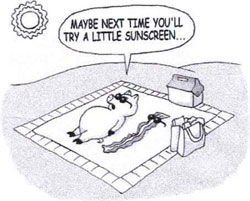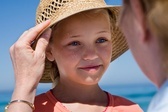 |
 |
THE SUN IS GREAT!
...except if you want healthy, younger looking skin with less risk of cancer!

|
|
I wish to give credit to the cartoonist. If anyone knows who did this, please contact me.
|
 |
|
|
|
 |
This wonderful cartoon says it all. I'm asked all the time what the best anti-aging product or treatment is. I always answer, "The best product is your sun-screen, and the best treatment is sun avoidance ~ not abstenence!"
~Ruth Ann Holloway, PMAE, LMT
To maintain a youthful appearance, Sun Smarts can go a long way!
The sun can heal us or harm us! We need to respect this powerful force given to us. Sun promotes health when not abused for tanning. We need it to be healthy, for our bones and skin. Sun should touch our bodies with early and later day light. Bright mid-day (10-4:00) can be harmful if not respected. Every person has thier own sun "tolerance". If you burn, like I do, go only 20 minutes, but split it up to 2x a day for 10 minutes each session.
If you have "bacon baked" your skin and it is showing signs of aging, dehydration, and hyperpigmentation, there is hope! For photo ~ "photon atomic fall out" sun damage ~ there are treatments, diet changes, and products to help restore a more youthful appearance, reduce brown hyper-pigmentation, and prevent future damage. Call today and we can brighten your skin and your smile!
Dimensions™ Progressive Skin Therapy™
Sun Care Products:
-
Mineral Makeup, SPF 26 Elegant pure mineral foundation, cased in an convenient silver compact with mirror and sponge. 100% pure mineral powder. No talc, no additives. This foundation is triple milled allowing for the smoothest even application. Because it is triple milled it can be applied for intense coverage to hide imperfections, or sheer as a finishing foundation. Several shades and easy tips for application, adds even more protection and beauty for your skin.
-
Parasol Sun Shield SPF 30 A client favorite! An Anti-Aging formula, light weight moisturizer with SPF 30 for all skin types. Marvelously formulated with Green Tea and Alpha Lipoic for Anti-Oxidant and combat protection against free radical damage. Creatively combined with the newest nano-technology for delivery of wrinkle reducing ingredients. A true anti-aging product to keep your skin protected and younger looking!
-
All are kind to the skin and will not sting eyes. Each are water resistant.
-
-
A short video about cancer.
-
For a life time of beautiful skin!
By appointment. Go to More Information Page.
Providence, Utah
|
|
Sun Tips
Recognize, treat and prevent heatstroke. Signs of heatstroke include dry and warm skin- victims don't perspire; a strong, fast pulse; very high temperature and strange, perhaps confused, behavior. If left untreated the victim could lose consciousness. Call an ambulance immediately. Move the person into a cooler area and apply cool water to the skin. Never leave anyone unattended in a car in the summer. Temperatures inside a car can reach 160 degrees and quickly can cause death.
SUN SAFETY 101
Skin cancer, if not completely preventable, can at least be successfully treated if caught early. The following can help you protect yourself.
- Sun is for healing the body, not baking the body.
Avoid the sun between 10 a.m. and 4 p.m., when the sun's rays are strongest. Help your immune system by getting 20 minutes of sun outside of 10-4pm.
- Cover up.
For extended times when being in the sun, wear long pants and shirts with sleeves. If the sun can't get to you, it can't damage your skin
- Wear a hat.
Wearing a hat with a 4-inch brim will protect your face and neck.
- Make it routine.
Use a broad-spectrum sunscreen every day and start putting it on your kids at age 6 months.
- Go higher.
If you'll be outside for any length of time, use a sunscreen with an SPF of 30, but never less than SPF 15.
- Re-apply.
Even water resistent sunscreens need to be re-applied every two hours for maximum protection in the midday sun, especially for small children. Remember, water reflects and magnifies the suns UVB - burning - rays.
- Look for changes.
Growing, bleeding, crusting, or otherwise changing spots on the skin could indicate a problem. These include asymmetry (one half unlike the other half), irregular borders, varied color (shades of brown, black, or even white, blue or red) and spots which are larger than a pencil eraser.
- Get to know your skin.
Practice skin self-exams to become familiar with your body's "topography." Once a month, examine your body for moles and dark spots, making note of those that appear to have changed and seeing your dermatologist immediately. Change does not necessarily mean skin cancer, but get them checked out to put your mind at ease.
Are You At Risk?
Certain factors may predispose you to getting skin cancer, even if you've never spent time in the sun. Some of these sun- and gene-related risk factors include:
- Fair skin
- Light hair
- Tendency to freckle
- Tendency to burn easily
- A family history of the disease
- Chronic sun exposure throughout life
- Blistering sunburns as a child or adolescent.
Prevention!
-
Wear loose-fitted clothing. This is important, especially around the head and neck., and stay in well-venteialated areas. When hiking a wet cool cloth around the neck can bring the body temperature down.
-
Wear your sunscreen! You'll need an SPF of at least 30, natual mineral based is best. Reapply often to keep the skin protected.
-
Practice water safety. Always know where young children are at, especially near water. Make sure swimming areas are safe, and wear goggles to protect eyes when swimming in chlorinated water.
-
Be safe. Wear shoes when in parks to avoid cuts from glass and other objects.
-
Ask about Vitamin D supplements to insure proper Vit. D. in your system. Get 20 minutes of sun every day as mentioned above. AND eat raw food, especially fruits, that are highly colored for antioxidant protection to every cell of your body.
-
Fun in the sun is what summer is all about- just play it safely.
Dermal Dimension Skin Care Therapy
Providence, Utah ...near Logan in Beautiful Cache Valley Utah
Home Page: www.ddskintherapy.com
|
 |
 |
|
 |
 |
DO YOU KNOW? The FDA released new regulations for sunscreens and sunscreen labeling last the summer of 2011. Here are the FDA’s main points:
- Broad Spectrum designation. Sunscreens that pass FDA’s broad spectrum test procedure, which measures a product’s ultraviolet A (UVA) protection relative to its ultraviolet B (UVB) protection, may be labeled as “Broad Spectrum SPF [value]” on the front label…
- Use claims. Only Broad Spectrum sunscreens with an SPF value of 15 or higher can claim to reduce the risk of skin cancer and early skin aging if used as directed with other sun protection measures. Non-Broad Spectrum sunscreens and Broad Spectrum sunscreens with an SPF value between 2 and 14 can only claim to help prevent sunburn.
- ‘Waterproof,’ ‘sweatproof’ or ‘sunblock’ claims. Manufacturers cannot label sunscreens as “waterproof” or “sweatproof,” or identify their products as “sunblocks,” because these claims overstate their effectiveness. Sunscreens also cannot claim to provide sun protection for more than 2 hours without reapplication or to provide protection immediately after application (for example– “instant protection”) without submitting data to support these claims and obtaining FDA approval.
- Water resistance claims. Water resistance claims on the front label must indicate whether the sunscreen remains effective for 40 minutes or 80 minutes while swimming or sweating, based on standard testing. Sunscreens that are not water resistant must include a direction instructing consumers to use a water resistant sunscreen if swimming or sweating.
- Drug Facts. All sunscreens must include standard ‘Drug Facts’ information on the back and/or side of the container.”
- All products that need to be FDA approved (sunscreen is considered an over-the-counter drug by the FDA and requires extensive testing) must pay fees just to undergo testing.
Traditionally there have been two types of sun protection: Sunscreen and Sunblock. Sunscreen uses manmade chemicals like Oxybenzone, Octyl methoxycinnamate, Avobenzone, Benzophenone, and Octocrylene. Research is showing the high levels of chemicals in products claiming SPF 45 or higher, may be more dangerous to the cells than the sun, linking sunscreen use to hormone imbalances, skin cancer, Vitamin D deficiency, and erectile dysfuncion.
Physical Sunblock uses inert, safe minerals like Zinc Oxide and Titanium Dioxide to reflect and scatter UVA, UVB, and UVC rays before they penetrate within the skin causing damage. A great example is the thick, white paste that lifeguards have used for to protect their noses. Modern Sunblock has been refined and is essentially translucent. It feels much like fine mineral makeup, and can wear off in a similar way making reapplication essential every two hours, as is recommended for most sunscreens.
To increase Vitamin D naturally without causing undo photo-damage, Dr. Mercola recommends getting 15minutes (I prefere 20, split up 2x a day for 10 minutes each, as this is what Dr. Pugliese had me do to rid my neck of persistent contact dermatitis and it worked! ) of sun exposure before applying sun protection, or a little longer if your skin is more sun-resistant. The best light is early in the morning, not in the afternoon when rays are intense.
When choosing a Sunblock, look for SPF 30. Anything more will have an abundant dose of chemicals, and the effectiveness is minimal for the risk of skin cancer. Dr. Spencer of AAD stated, “SPF 30 product blocks 97% of UVB rays, and an SPF 45 product blocks about 98% of rays. After that it just gets ridiculous.” No product is capable of 100% protection.
When you do have sun activities, enjoy them. Reapply sun protection every 2 hours to maintain your near-perfect coverage.Make sure to apply enought product, and massage in well. Fair skinned persons should be careful not to get burned.
©Pages, photos, Artwork, Art, and information on this site are protected by copyright laws. Penalties start at $10,000.00.
|
|
|
|